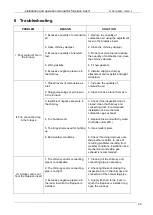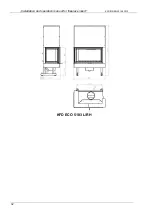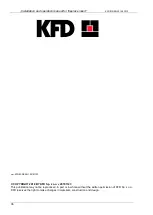
„Installation and operation manual for fireplace insert”
KFDECOENG1.1562012
22
During the heating system, a system based on circulation of hot air handles very high
quantities of air carrying dust particles (
which, unfortunately, cannot be avoided in today’s
environment), which in time deposit inside the fireplace enclosure and on grates of
convection air as well as on blades of the air turbine. To keep the system operational,
maintain silent operation of the turbine and keep hygiene at home, thoroughly dust all the
above elements of the system using a brush and an ordinary vacuum cleaner.
2.4.4 Removal of ash
KFD ECO fireplace inserts are not equipped with an ash grate or ash box. Ash from
combustion of wood accumulates on the furnace board. The combustion chamber ought to
be emptied regularly, leaving only a thin layer of ash required for improved conditions of
wood combustion. Removed ash should be placed in a container with a lid, made from non-
combustible material. The container ought to be placed on a base made from fire resistant
materials, at an appropriate distance from any combustible materials, and allowed to cool
down completely. Due to safety reasons, at least once a year check cleanliness of the duct
supplying outdoor air (with particular focus on the air intake located outside the building). The
chimney ought to be cleaned regularly by a chimneysweep who should also check whether
the fireplace installation is constructed properly, inspect connection of the insert to the
chimney as well as ventilation.
2.4.5 Summer break in using the fireplace
In case of high humidity of the room where the fireplace insert is installed, place a humidity
absorbent (“silica gel”) in the insert..
2.5 Fireplace fuel
Irrespective of the class, type or make of the fireplace insert, the quality of fuel used is crucial
to proper operation, efficiency and durability of the device. The only fuel allowed in closed
fireplaces is the wood of deciduous trees. To enable economical usage guaranteeing your
satisfaction with the fireplace, wood ought to be seasoned for at least 18 months in the open
air, e.g. under an umbrella roof, sawn and split. This allows appropriate wood humidity (20%),
required for proper operation of the fireplace. It ought to be emphasised that 1 m³ of wood
with the humidity of 20% contains app. 60 l of water, whereas the same quantity of wood two
months after cutting down contains as much as 350 litres of water. If the latter is used in the
fireplace, it will result in quick soiling of the glass pane, corrosion of the insert, erosion of the
chimney and, obviously, the house will not be heated. Recent research (including ecological
research) indicates high importance of wood as ecological renewable fuel. First of all,
combustion of wood does not increase the greenhouse effect or the so-called ozone hole,
because wood
– whether burned in the fireplace or decomposed naturally – emits into the
atmosphere the same quantity of carbon dioxide (CO
2
). Combustion residues do not contain
sulphur, chlorine or other harmful chemical substances. Exhaust gases contain only water
and carbon dioxide, whereas ash is an excellent natural fertiliser because it contains all
mineral salts needed by plants.
The furnace should contain no more than 2-3 chunks with the length of app.
33-50 cm
(
and
diameter of 10-15 cm. Prohibited fuels include coal, briquettes, waste, remainders of bark or
laminated panels, humid wood, processed wood (e.g. lacquered wood) and plastics. If such
materials are used for combustion, the guarantee expires. Paper or cardboard may only be
used for lighting up.
Burning of waste is prohibited as this is hazardous to the device and to human health.















































